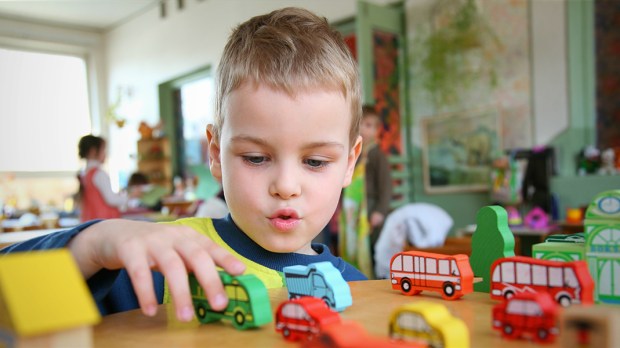My oldest son Liam turned 5 barely three weeks before the cutoff date for kindergarten. I had planned to hold him back a year and put him in as a 6-year-old, but Florida’s free preschool system put a wrench in those plans. He wouldn’t get free preschool as a 5-year-old … even if he was just barely 5. And since I had opted out of putting him in preschool as a barely-4-year-old, I was stuck. It was kindergarten or nothing, for another whole year.
Read more:
What if I can’t afford Catholic school for my kids?
All his friends were going to kindergarten, and he wanted to go too. Liam is the calmest and most precocious of my children, so he seemed ready. But I was haunted by my mom’s regret at sending my little brother to kindergarten in similar circumstances. She always worried that it had put him at a disadvantage, not intellectually but socially.
Concerns about when to put a boy in school are common. There’s even a term for holding kids back if they’ve reached the age cutoff: “redshirting.” Katie Bingham-Smith wrote about her own struggle with whether or not to redshirt her son, and her subsequent regret that she didn’t, over at Scary Mommy.
“Then, in his second-grade year, he began to fall behind. My son stopped enjoying school as much as he had the two years prior … As parents, we always wonder if we could have made a different decision that would have worked out better for our kids. Would my son be a model student had I not sent him to school when he was 4? If redshirting wasn’t a thing, would I even feel this way or would I just assume he was having a tough year?”
There’s no definitive data that shows redshirting to be beneficial. In fact, some studies have shown that it stunts intellectual development, while others show improved self-regulation in children who start a year late.
Personally, I believe we should be more concerned about the insane demands of American kindergarten than whether or not kids can benefit from going a year later. But in the end, the choice to redshirt or not comes down to the parent and the child.
Each kid is different. I ended up putting Liam in kindergarten even though it made him the youngest in his class, and he thrived. But his character is particularly suited to the American kindergarten model. He does worksheets for fun. He likes sitting quietly at a desk or table, reading and doing math problems. I have never met a child like him before, and although I do sometimes worry that he will be behind his classmates in emotional maturity, I never worry about him being at an academic disadvantage.

Read more:
Why giving grades destroys education
His little brother Lincoln is the exact opposite. I call him a Tasmanian Devil, because that’s what he is. His birthday, thank the Lord, is late. He’ll be nearly 5 when he starts preschool, which is fantastic because he still has a hard time differentiating hugs from body-slams. If he had been born near the cut-off date like Liam, I absolutely would have redshirted him — out of concern for the safety of his classmates, if nothing else.
If you’re on the horns of the redshirt dilemma, don’t make the decision based on what will give your child an academic or physical advantage. Make your decision based on what you know about this child, at this time, and how he or she will fit into this school.
The truth is, we can’t know which decision will ultimately be a boon or a burden for our children. That’s one of the hardest things about parenting. All we can do is our best for the children we know and love better than anyone else.
Don’t worry. Your best is enough.

